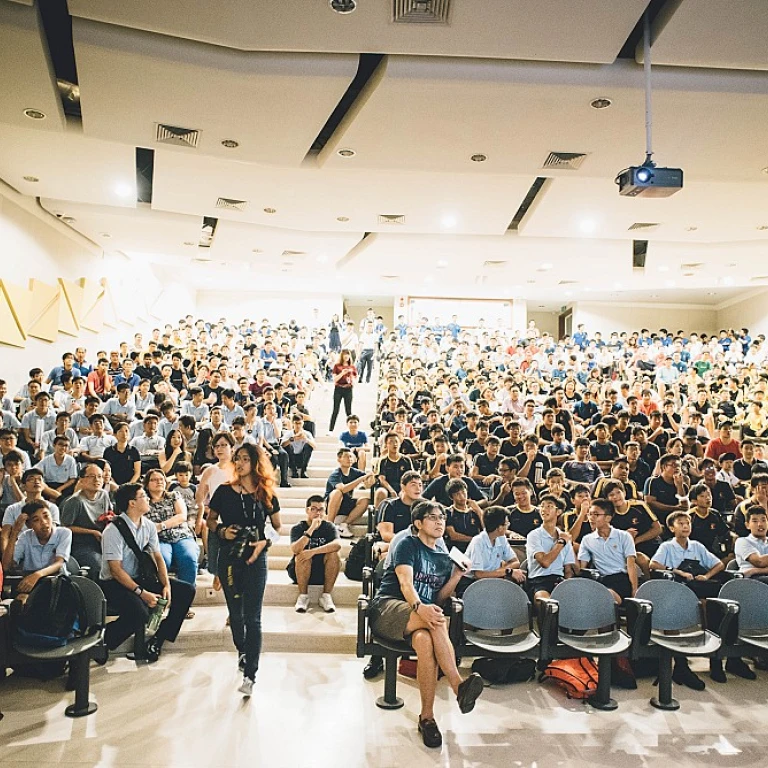The Changing Face of Work
Embracing Transformation in the Workplace
The digital revolution is reshaping the workforce landscape at a speed we've never witnessed before. New technologies emerge, industries evolve, and digital skills are in higher demand, forcing businesses and professionals to adapt swiftly. This transformation is not about replacing the current with the new; rather, it involves a dynamic blend of both. The changing face of work presents a compelling need for reskilling and upskilling initiatives as a means to not just survive but thrive in this digital world.
In understanding the current workplace shifts, it's essential to look at how artificial intelligence, robotics, and automation have altered the way we approach tasks. Many traditional roles are being redefined, requiring a fresh set of skills that align with these technological advancements. The notion that one can learn a skill set in the early years of their career and ride it out to retirement is now obsolete. Instead, the modern professional journey is marked by lifelong learning.
Organizations that recognize and promote this shift by investing in reskilling enable their workforce to keep pace with changes, creating a culture of innovation and flexibility. This commitment to employee development is crucial for ensuring business continuity and competitiveness in the rapidly transforming digital landscape.
To better understand how the digital shift is influencing job markets and career opportunities, exploring strategies for
reskilling for the digital shift can provide deeper insights into preparing for tomorrow's workforce. Addressing these changes head-on through a strategic approach to reskilling can not only empower employees but also future-proof the organizations they work for, making the transition smoother and more sustainable.
Upskilling vs. Reskilling: What's the Difference?
Navigating the Professional Landscape: A Close Look at Upgrading Skills
As the professional landscape continues to evolve at a breakneck speed, the distinction between upskilling and reskilling becomes crucial for both individuals and organizations. Understanding these two concepts can pave the way for a more adaptable and resilient workforce.
Upskilling usually involves enhancing and expanding already existing capabilities. It may pertain to mastering a new technology or gaining more advanced skills within an individual's current job scope. This approach is often seen in industries where digital tools are continuously being updated, necessitating a deeper understanding to remain competitive in today’s market.
Reskilling, on the other hand, involves learning new skill sets entirely, often in preparation for a career shift. This strategy becomes vital as old jobs become obsolete and new roles emerge in a digital world. For example, individuals in declining industries may reskill to enter growing sectors, like transitioning from traditional manufacturing to the digital manufacturing field.
The decision between upskilling and reskilling is dictated by the unique demands of the industry and the employee's career aspirations. Organizations that accurately differentiate between these needs and implement effective programs will not only retain their talent but also attract new ones. Fortunately, the path to expanding one's professional capacity has never been clearer.
Employees and employers alike should strategize for future career resilience by selecting the most effective approach, whether it be upskilling or reskilling. To further explore the avenues available, consider how you can
boost your career with skill upgrades, paving the way for professional advancement and security.
The journey of enhancing one’s skill set, whether by honing existing skills or learning entirely new ones, not only strengthens the individual worker but also future-proofs your organization in a rapidly changing digital world. It aligns seamlessly with the ongoing theme of our discussion on thriving in a digital age, requiring both current and fresh skill sets.
Real Stories of Reskilling Success
Inspirational Turnarounds in the Workforce
The digital age has brought a wave of stories showcasing the power of reskilling, turning what could have been challenges into triumphs across various industries. Each narrative validates the importance of embracing change and highlights the transformative outcomes that reskilling can offer.
Take Sarah, for instance, who spent over a decade in retail management. Faced with job uncertainty due to the rising trend of e-commerce, she decided to embark on a reskilling journey. Enrolling in a digital marketing program, she leveraged her understanding of customer behavior and retail trends, successfully transitioning into a role as a digital marketing strategist. Sarah's story is a testament to how reskilling can open doors to new career paths while utilizing existing skills in innovative ways.
Then there's Carlos, an engineer who found himself stuck as his industry began leaning heavily towards automation. Determined to keep his skillset relevant, Carlos immersed himself in software development courses. The transition wasn’t just a career shift; it led to his current role as a tech lead in a prominent tech firm. Carlos's commitment to continuous learning exemplifies the critical role that ongoing education plays in navigating career shifts.
For ambitious professionals like Sarah and Carlos, reskilling has become a crucial catalyst for growth. These real-world examples highlight how unlocking potential with reskilling training programs can lead to rewarding professional transformations, enabling individuals to find new, exciting opportunities and thrive amidst the fast-paced digital economy.
The Role of Continuous Learning
The Importance of Lifelong Learning
In our current work landscape, the only constant is change. With the digital transformation sweeping across industries, organizations and individuals alike must recognize the significance of continuous learning to remain relevant. The pursuit of knowledge should not be a one-time effort but rather a lifelong journey. As we delve deeper into the digital era, the notion of reskilling becomes intertwined with perpetual learning.
Lifelong learning not only empowers employees to keep pace with technological advancements but also endows them with the agility to adapt to evolving roles and responsibilities. By fostering a culture of continuous education, companies can seamlessly integrate reskilling into their strategic frameworks. This ensures that their workforce is not just surviving but thriving in the face of change.
Organizations that prioritize continuous learning are already reaping the rewards. They experience reduced turnover rates, increased innovation, and enhanced employee engagement. These companies encourage their employees to take charge of their professional development by providing access to learning resources, upskilling programs, and mentorship opportunities.
For individuals, the commitment to lifelong learning serves as a catalyst for personal and professional growth. It breaks the barrier of complacency and stirs the curiosity needed to explore new skills and capabilities. By embracing this mindset, employees can transform potential challenges into opportunities for development, growth, and career advancement.
Ultimately, the role of continuous learning in the context of reskilling cannot be overstated. It is the driving force that enables both individuals and organizations to stay relevant and competitive in a digital world where change is the only certainty.
Overcoming Challenges in Reskilling
Confronting the Roadblocks
Navigating the journey of reskilling can bring about a set of challenges that both individuals and organizations must be prepared to tackle. These obstacles, while daunting, are not insurmountable when addressed with strategic approaches and a forward-thinking mindset.
One of the most significant hurdles in reskilling efforts is resistance to change. This resistance can stem from various sources, including fear of the unknown, a fixed mindset, or simply an attachment to familiar routines. Overcoming this barrier requires fostering a culture of openness and adaptability within workplaces. Encouraging employees to embrace continuous learning and illustrating the tangible benefits of gaining new skills can gradually dissolve hesitance.
Another challenge arises from the diverse skill levels and learning styles within a workforce. A one-size-fits-all approach to training can lead to disengagement and ineffective learning outcomes. Personalizing the reskilling journey to align with individual needs not only enhances engagement but also ensures that each employee can effectively contribute to the company's growth.
Furthermore, time constraints and operational pressures often limit the ability to prioritize skill development. Businesses need to strike a balance between maintaining productivity and allowing their teams adequate time for growth and learning. This might mean integrating learning pathways into daily workflows or offering flexible learning solutions, ensuring that reskilling becomes a seamless and valued part of the work culture.
Finally, the financial aspect cannot be ignored. Investment in reskilling programs can be perceived as a costly endeavor. However, it is crucial to recognize this as an investment in the organization's future resilience. Allocating resources to reskilling, whether through internal training resources or external partnerships, is integral to maintaining a competitive edge and future-proofing the workforce.
Through recognizing and addressing these challenges head-on, organizations and individuals alike can transform potential roadblocks into opportunities for growth and success in the digital age.
Future-Proofing the Workforce
Embracing a Culture of Adaptability
In a world where technological advancements are reshaping industries at an unprecedented pace, future-proofing the workforce is more crucial than ever. The changing face of work has highlighted the need for employees to not only adapt but to thrive in this dynamic environment. As we've discussed, the distinction between upskilling and reskilling plays a pivotal role in this journey, with each offering unique pathways to equip individuals with the skills needed for tomorrow's challenges.
Investing in Lifelong Learning
A key strategy in future-proofing the workforce is fostering a culture of continuous learning. Organizations must encourage their employees to engage in ongoing education and training opportunities. This not only enhances individual capabilities but also strengthens the organization's overall adaptability. By investing in lifelong learning, companies can ensure their teams are equipped to handle emerging technologies and industry shifts.
Building Resilience Through Collaboration
Another essential component of preparing for the future is promoting collaboration across different sectors and disciplines. By breaking down silos and encouraging cross-functional teamwork, businesses can cultivate a more resilient workforce. This approach allows employees to gain diverse perspectives and skills, making them more versatile and better prepared to tackle complex problems.
Navigating Challenges with Agility
While the path to reskilling success is not without its challenges, overcoming these obstacles is vital for future-proofing careers. As we've seen, real stories of reskilling success demonstrate that with the right support and resources, individuals can navigate these challenges with agility and confidence. Organizations must be proactive in identifying potential barriers and providing solutions that empower their workforce to succeed.
Looking Ahead
As we look towards the future, it's clear that the ability to adapt and evolve will be the cornerstone of a successful career. By embracing a culture of adaptability, investing in lifelong learning, and fostering collaboration, organizations can effectively future-proof their workforce, ensuring they remain competitive and innovative in the digital age.








